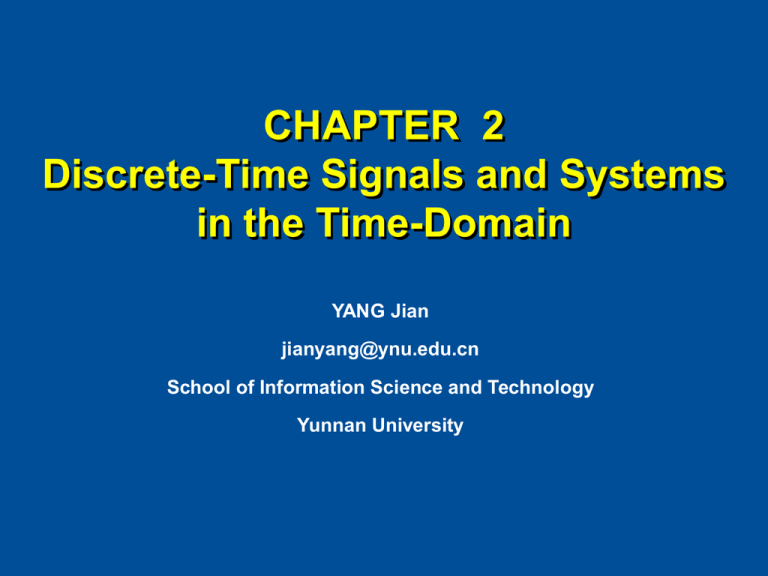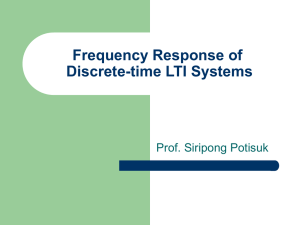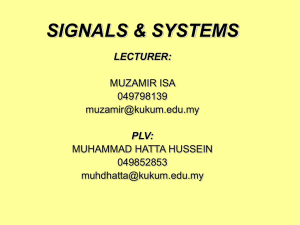第2章DSP_Chapter_02 下载
advertisement

CHAPTER 2
Discrete-Time Signals and Systems
in the Time-Domain
YANG Jian
jianyang@ynu.edu.cn
School of Information Science and Technology
Yunnan University
Outline
• Discrete-Time Signals
• Typical Sequences and Sequence Representation
• The Sampling Process
• Discrete-Time Systems
• Time-Domain Characterization of LTI DiscreteTime Systems
• Finite-Dimensional LTI Discrete-Time Systems
• Correlation of Signals
• Summary
云南大学滇池学院课程:现代信号处理数字信号处理
Digital Signal Processing 2
Discrete-Time Signals
• Basic signals
– Unit sample or unit impulse sequence
– Unit step sequence
– Exponential sequence
• Signal classification
– Continuous-time / discrete-time signals
– Deterministic / random signals
– Energy signals
• signals with finite energy
– Power signals
• signals with finite power
– Energy signals have zero power, and power signals have
infinite energy
云南大学滇池学院课程:现代信号处理数字信号处理
Digital Signal Processing 3
Discrete-Time Signals
• Time-Domain Representation
– Sequence of numbers:
•
x(n)
•
n
•
— sequence
— samples
x ( n) — sample value or nth samples, a real or complex
value
– Figure of sequence:
x(n)
,0.3,0.76,0,1, 2,0.92,
• x ( n) is defined only for integer value of n
云南大学滇池学院课程:现代信号处理数字信号处理
Digital Signal Processing 4
Discrete-Time Signals
• Operation on sequences
– Basic operation
• Adder / Subtraction:
x1 (n) x2 (n) y(n)
• Scalar multiplication ( gain / attenuation ):
• Delay / Advance:
Ax( n) y( n)
x(n n0 ) y(n)
– Combination of Basic Operations
• Multiplier:
x1 (n) x2 (n) y(n)
• Linear combination:
云南大学滇池学院课程:现代信号处理数字信号处理
a1 x1 (n) a2 x2 (n 3) y(n)
Digital Signal Processing 5
Discrete-Time Signals
• Operation on sequences
– Sampling Rate Alteration ( special operations of for
discrete-time signals )
• Up-sampling:
x( n / L),
y( n)
0,
n 0, L, 2 L, ,
otherwise ,
• Down-sampling:
y( n) x( nM )
云南大学滇池学院课程:现代信号处理数字信号处理
Digital Signal Processing 6
Discrete-Time Signals
• Classification of Sequences
– The number of sequences: finite / infinite
• Finite-length sequences:
x(n) 0, n N1 and n N 2
– Symmetry
• conjugate-symmetric ( even ):
• conjugate-antisymmetric ( odd ):
x ( n) x ( n)
x ( n) x ( n)
– Periodity: periodic / aperiodic
• Periodic sequence:
x(n) x(n kN ),
云南大学滇池学院课程:现代信号处理数字信号处理
for all n, k is any integer.
Digital Signal Processing 7
Discrete-Time Signals
• Classification of Sequences
– Energy and Power Signals
energy :
power :
x
x ( n)
2
n
K
1
2
P lim
x
(
n
)
k 2 K 1
n K
energy signals :
power signals :
云南大学滇池学院课程:现代信号处理数字信号处理
x <, P
x , P
Digital Signal Processing 8
Discrete-Time Signals
• Classification of Sequences
– Other types of Classification
• Bounded:
x ( n) Bx
• Absolutely summable:
n
• Square-summable:
x ( n)
2
x ( n)
n
云南大学滇池学院课程:现代信号处理数字信号处理
Digital Signal Processing 9
Typical Sequences and Sequence
Representation
• Some Basic Sequences
– Unite sample sequence:
1,
0,
( n)
n0
n0
• An arbitrary sequence can be represented by unite sample
sequence in time-domain
– Unite step sequence:
( n)
n
(k ),
1,
( n)
0,
n0
n0
( n) ( n) ( n 1)
k
云南大学滇池学院课程:现代信号处理数字信号处理
Digital Signal Processing 10
Typical Sequences and Sequence
Representation
• Sinusoidal and Exponential Sequences
– The real sinusoidal sequence:
x(n) A cos(0 n ),
n
– The exponential sequence:
x( n) A n Ae ( 0 j0 ) n A e 0ne j (0n )
A e 0n cos(0 n ) j A e 0n sin(0 n )
• The sinusoidal sequence are periodic of period N as long
as N is an integer multiple of 2 . The smallest
0
possible N is the fundamental period of the sequence.
云南大学滇池学院课程:现代信号处理数字信号处理
Digital Signal Processing 11
Typical Sequences and Sequence
Representation
• Some Typical Sequences
– Regular window sequence:
1,
w R ( n)
0,
0 n N 1
otherwise
– Real exponential sequence:
x ( n) a n ( n )
• Representation of an Arbitrary Sequence
– An arbitrary sequence can be represented as a weight
sum of basic sequence and its delayed version.
x ( n)
x(k ) (n k )
k
云南大学滇池学院课程:现代信号处理数字信号处理
Digital Signal Processing 12
The Sampling Process
• Uniform sampling:
– Often the discrete-time sequence is developed by
uniformly sampling a continuous-time signal xa ( t ):
x(n) xa (nT )
• F 1 T , the sampling
T
frequency
• 2 F , the sampling
T
T
angular frequency
云南大学滇池学院课程:现代信号处理数字信号处理
Digital Signal Processing 13
The Sampling Process
• Aliasing:
– When T 2 MAX , a continuous-time sinusoidal signal of
higher frequency would acquire the identity of a
sinusoidal sequence of lower frequency after sampling.
e.g.
云南大学滇池学院课程:现代信号处理数字信号处理
Digital Signal Processing 14
Discrete-Time System
• Discrete-time system
y( n) H [ x( n)]
Input x(n)
- n
H[]
Output y(n)
• Simple Discrete-Time Systems
– The accumulator
– The M-point moving-average filter
– The factor-of-L interpolator
云南大学滇池学院课程:现代信号处理数字信号处理
Digital Signal Processing 15
Discrete-Time System
• Classification of Discrete-Time System
– Linear system:
if
x1 (n) y1 (n), x2 (n) y2 (n),
then
x1 (n) x2 (n) y1 (n) y2 (n)
– Shift-Invariant System:
if x(n) y(n), then x( n n0 ) y( n n0 )
– LTI System:
The linear time-invariable discrete-time system satisfies
both the linear and the time-invariable properties.
云南大学滇池学院课程:现代信号处理数字信号处理
Digital Signal Processing 16
Discrete-Time System
• Classification of Discrete-Time System
– Causal System:
In a causal discrete-time system, the n0 th output sample
y( n0 ) depends only on input samples x ( n) for n n0 and
does notdepend on input samples for n n0 .
if u1 ( n) y1 ( n)
then
and
u2 ( n) y2 ( n)
{u1 ( n) u2 ( n), for n N }
implies also that { y1 ( n) y2 ( n), for n N }
云南大学滇池学院课程:现代信号处理数字信号处理
Digital Signal Processing 17
Discrete-Time System
• Classification of Discrete-Time System
– Stable System:
Definition of bounded-input, bounded-output ( BIBO ) stable.
x( n) Bx , n
if
then
y( n) B y , n
• Passive and Lossless Systems
– The passivity:
n
– The losslessness:
2
y ( n)
2
x ( n)
n
the same energy
云南大学滇池学院课程:现代信号处理数字信号处理
Digital Signal Processing 18
Discrete-Time System
• Impulse and Step Responses
– Input sequence → output sequence
– Impulse response h( n) :
– Step response s( n) :
云南大学滇池学院课程:现代信号处理数字信号处理
( n) h( n)
( n) s( n)
Digital Signal Processing 19
Time-Domain Characterization of LTI
Discrete-Time Systems
• Input-Output Relationship
– The response y(n) of the LTI discrete-time system to x(n)
will be given by the convolution sum:
y ( n)
k
k
x(k )h(n k ) x(n k )h(k )
x( n) h( n)
– The operation
h( k ) h( k )
h( k ) h(n k )
Step 2, shift n sampling period:
• Step 1, time-reverse:
•
• Step 3, product:
x( k )h( n k ) v( k )
• Step 4, summing all samples:
云南大学滇池学院课程:现代信号处理数字信号处理
k
k
v(k ) x(k )h(n k )
Digital Signal Processing 20
Time-Domain Characterization of LTI
Discrete-Time Systems
• Some useful properties of the convolution
operation
– Commutative:
x1 (n) x2 (n) x2 (n) x1 (n)
– Associative for stable and single-sided sequences:
x1 (n) [ x2 ( n) x3 ( n)] [ x1 ( n) x2 ( n)] x3 ( n)]
– Distributive:
x1 (n) [ x2 (n) x3 (n)] x1 (n) x2 (n) x1 (n) x3 ( n)]
云南大学滇池学院课程:现代信号处理数字信号处理
Digital Signal Processing 21
Time-Domain Characterization of LTI
Discrete-Time Systems
• Simple Interconnection Schemes
– Cascade Connection:
h(n) h1 (n) h2 (n)
h1 (n) h2 (n) h2 (n) h1 (n) h1 (n) h2 (n)
– Parallel Connection:
h1 ( n)
h2 ( n)
– Inverse System:
云南大学滇池学院课程:现代信号处理数字信号处理
h(n) h1 (n) h2 (n)
h1 (n) h2 (n)
h1 (n) h2 (n) (n)
Digital Signal Processing 22
Time-Domain Characterization of LTI
Discrete-Time Systems
• Stability Condition in Terms of the Impulse Response
– An LTI digital filter is BIBO stable if only if its impulse
response sequence h( n) is absolutely summable, i.e.:
S
h( n)
n
• Causality Condition in Terms of the Impulse Response
– An LTI discrete-time system is causal if and only if its
impulse response is a causal sequence satisfying the
condition:
h( k ) 0,
云南大学滇池学院课程:现代信号处理数字信号处理
for k 0
Digital Signal Processing 23
Finite-Dimensional LTI Discrete-Time
Systems
• The difference equation:
– An important subclass of LTI discrete-time systems is
characterized by a linear constant coefficient difference
equation of the form:
N
d
k 0
M
k
y( n k ) pk x ( n k )
k 0
– The order of the system is given by max( N, M )
云南大学滇池学院课程:现代信号处理数字信号处理
Digital Signal Processing 24
Finite-Dimensional LTI Discrete-Time
Systems
• Total Solution Calculation
– The complementary solution
• The homogeneous difference equation:
• The characteristic equations:
云南大学滇池学院课程:现代信号处理数字信号处理
Digital Signal Processing 25
Finite-Dimensional LTI Discrete-Time
Systems
• Total Solution Calculation
– The particular solution y p ( n) is of the same form as
specified input x ( n) .
– The total solution:
云南大学滇池学院课程:现代信号处理数字信号处理
y( n) yc ( n) y p ( n)
Digital Signal Processing 26
Finite-Dimensional LTI Discrete-Time
Systems
• Zero-Input Response and Zero-State Response
– zero-input response = complementary solution with
initials;
– zero-state response = the convolution sum of x(n) and
h(n).
if x( n) 0 the solution is yzi ( n),
and if applying the specified input with
all initial conditions set to zero the solution is yzs ( n),
then the total solution is :
云南大学滇池学院课程:现代信号处理数字信号处理
y zi (n) y zs ( n)
Digital Signal Processing 27
Finite-Dimensional LTI Discrete-Time
Systems
• Impulse Response Calculation
云南大学滇池学院课程:现代信号处理数字信号处理
Digital Signal Processing 28
Finite-Dimensional LTI Discrete-Time
Systems
• Impulse Response Calculation
– The solutions
云南大学滇池学院课程:现代信号处理数字信号处理
Digital Signal Processing 29
Finite-Dimensional LTI Discrete-Time
Systems
• Location of Roots of Characteristic Equation for
BIBO Stability
– A casual LTI system characteristic of a linear constant
coefficient difference equation is BIBO stable, if the
magnitude of each of the roots its characteristic
equation is less than 1.
– The necessary and sufficient condition:
k 1
云南大学滇池学院课程:现代信号处理数字信号处理
Digital Signal Processing 30
Finite-Dimensional LTI Discrete-Time
Systems
• Classification of LTI System
– Based on impulse response length
• Finite impulse response ( FIR ):
h(n) 0, for n N1 and n N 2 , with N 1 N 2
y( n)
N2
h(k ) x(n k )
k N1
• Infinite impulse response ( IIR ):
n
y( n) x ( k )h( n k )
k 0
云南大学滇池学院课程:现代信号处理数字信号处理
Digital Signal Processing 31
Finite-Dimensional LTI Discrete-Time
Systems
• Classification of LTI System
– Based on the output calculation process
• Non-recursive system:
If the output sample can be calculated sequentially, knowing
only the present and pass input samples.
• Recursive system:
If the computation of the output involves past output
samples.
– Remarks:
• FIR — Non-recursive
• IIR — Recursive
云南大学滇池学院课程:现代信号处理数字信号处理
Digital Signal Processing 32
Correlation of Signals
•
Definitions
–
A measure of similarity between a pair of energy signals, x(n)
and y(n), is given by the cross-correlation sequence defined
by:
rxy ( l )
ryx ( l )
x(n) y(n l ),
n
y( n) x ( n l )
n
rxy ( l )
–
l 0, 1, 2,
m
y(m l ) x (m ) rxy ( l )
y( n) x[( l n)] y( l ) x ( l )
n
The autocorrelation sequence of x(n) is given by:
rxx ( l )
云南大学滇池学院课程:现代信号处理数字信号处理
x ( n) x ( n l )
n
Digital Signal Processing 33
Correlation of Signals
• Properties of Autocorrelation and Cross-correlation
Sequences
– Set rxx (0) x 0 and ryy (0) y 0 as energies of the
sequences x(n) and y(n) , then we can get
rxx (0)ryy (0) rxy2 (l ) 0
or equivalently
rxy (l ) rxx (0)ryy (0) x y
– If y(n) = x(n), then
rxy (l ) rxx (0) x
• The sample value of the autocorrelation sequence has its
max value at zero lag ( l = 0 ).
云南大学滇池学院课程:现代信号处理数字信号处理
Digital Signal Processing 34
Correlation of Signals
• Properties of Autocorrelation and Cross-correlation
Sequences
– If y( n) bx( n N ) , where N is integer and b>0 is an
arbitrary number. In this case y b2 x, so
brxx (0) rxy ( l ) brxx (0)
云南大学滇池学院课程:现代信号处理数字信号处理
Digital Signal Processing 35
Correlation of Signals
• Normalized Forms of Correlation:
r (l )
xx ( l ) xx ,
rxx (0)
xy (l )
rxy ( l )
rxx (0)ryy (0)
• Correlation Computation for Power and Periodic Signals
– Power signals:
K
1
rxy ( l ) lim
x( n) y( n l ),
K 2 K 1
n K
K
1
rxx ( l ) lim
x ( n) x ( n l )
K 2 K 1
n K
– Periodic signals:
1
r (l )
xy
N
N
x(n) y(n l ),
n 0
云南大学滇池学院课程:现代信号处理数字信号处理
1
r (l )
xx
N
N
x ( n) x ( n l )
n 0
Digital Signal Processing 36
Summary
• The LTI system has numerous applications in
practice.
• The LTI system can be described by an inputoutput relation composed of a linear constant
coefficient difference equation.
• The LTI discrete-time system is usually classified
in terms of the length of its impulse response.
云南大学滇池学院课程:现代信号处理数字信号处理
Digital Signal Processing 37









